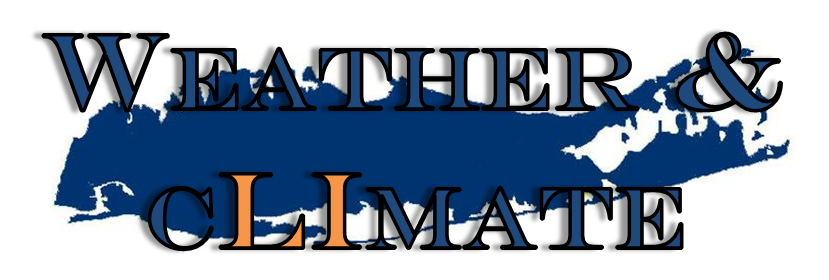The faculty and students of the Institute for Planetary Atmospheres (ITPA) at Stony Brook University hosts a weekly weather discussion where they lead a scientific discussion of the recent past, current, and future weather. This week's discussion was led by Dr. Brian Colle and was titled, "Why has the Atlantic hurricane season been so quiet and how long will it continue?"
Dr. Colle began
his discussion by providing some statistics to put the current Atlantic
hurricane season into perspective. He showed the National Oceanic and Atmospheric Administration's (NOAA) official forecast
from this past May for 13-20 named storms with 11 hurricanes and 3-6 major storms.
Their latest updated forecast changed a bit and called for 18 named storms with 8
hurricanes and 3 major storms. Despite the relatively “slow start” to the season they
are still calling for a lot of activity. The average historical peak for tropical cyclone (TC)
genesis in the North Atlantic is about the week of September 10th (NOAA/NHC),
so it’s not like we already missed the expected peak period of
activity. Dr. Colle discussed the quantity called accumulated cyclone
energy (ACE) which measures the relative intensity of each storm by
estimating the energy used by each storm (more info here). ACE can be used to compare relative intensities of storms or the relative intensity of an entire season. On a per-month basis, ACE also peaks in September in the Atlantic (from Dr. Ryan Maue’s page).
Given this information, perhaps this Atlantic hurricane season
shouldn’t yet be written off just yet but it looks like the date of the first
hurricane formation may break records (McNoldy, CWG) for being later than previously observed. ACE on a globally integrated scale has been decreasing since 2005 (Maue 2011) but that may be a result of there being less intense storms during the later period from 2005-2012 (Maue’s page).
What was the deal with the start of this Atlantic hurricane season?
To date there have been 6 named storms, none of which reached hurricane strength. Tropical cyclones gain their energy at the surface, unlike strong winter storms that predominately gain their energy from winds at upper-levels of the atmosphere. Tropical cyclones typically start as clusters of disorganized convection (thunderstorms) that blow towards the west off of the coast of Africa. However, they can form from many other locations but those that form from African easterly waves, or the organized storms off of Africa, are the focus of this discussion. Tropical cyclones feed their energy off of warm ocean waters and there are several factors that can hurt their formation and development. They need warm ocean waters, moist air and weak vertical wind shear or strong winds from the west at upper levels when there are strong winds from the east at lower levels.
Usually, the El Nino-Southern Oscillation (ENSO) when it is in its El Nino phase tends to contribute to a less active Atlantic hurricane season because of increased wind shear over the Atlantic. However, ENSO isn’t a major player this
season because it is in its neutral phase, so Dr. Colle showed some plots to explain why the activity had
been low starting on July 1st. The first point that he made was that there
was anomalously dry air in the atmosphere (-12% RH anomaly)
stretching westward from Africa all the way across the Atlantic into the
Caribbean especially during the period August 1st-15th. The Saharan Air
Layer (SAL) which is dry, dusty air originating from the Saharan Desert provided a harsh environment for TC development and growth.
In analyzing vertical stability or the resistance of the air to rise on its own, the Tropics are more stable this year
compared to average conditions (McNoldy, CWG)
so that would act to discourage convection. Sea surface temperature (SST) anomaly maps didn’t
show too much of an explanation for why activity has been weak because the Tropical Atlantic waters are quite warm. Maps of
upper-level shear anomalies did show that during the period August 1st-15th
there was a 2-3 m/s westerly shear anomaly in the tropical Atlantic
basin. Therefore, the weak activity was shown to be likely tied to the
dry air and westerly shear that created an unfavorable environment for
TC development.
How long will this stifled activity last?
Likely not long, Dr. Colle explained. Climatological shear values are
back in place and the dry anomalies are starting to weaken and the atmosphere is becoming more moist. At the time
of the discussion, there was an area of thunderstorms or an National Hurricane Center (NHC) invest area with a 40% probability for
the chance of development that should move westward into an area with
weaker shear but still some residual dry air. If it makes it past the
subtropical high, according to the GFS model,
it may encounter a trough that may recurve it and keep it away from the
Caribbean and East Coast. We’ll see what happens. Looking beyond this
one system and to the rest of the Atlantic hurricane season as a whole,
most students at the discussion agreed that they were not ready to give
up on the season yet. Assuming that the environment becomes more favorable for tropical cyclone development in the North Atlantic Ocean then this season's forecast for the number of storms may pan out.
For more information about tropical cyclone statistics visit the NOAA/NHC website: http://www.nhc.noaa.gov/climo/
For frequently asked questions about tropical cyclones visit the NOAA/NHC website:
http://www.nhc.noaa.gov/faq.shtml
